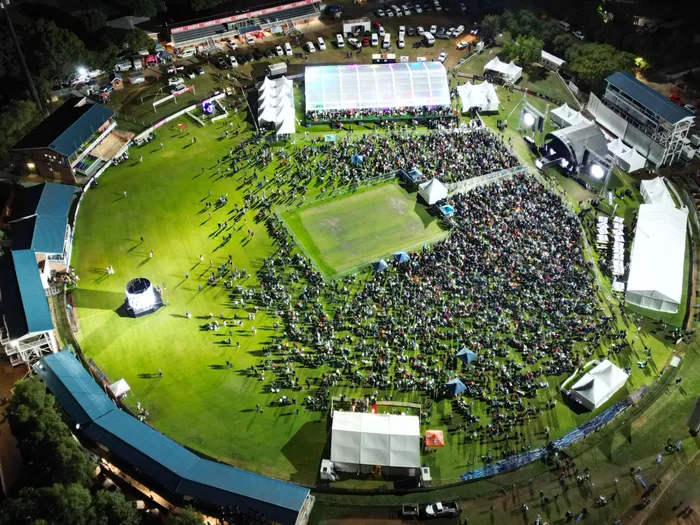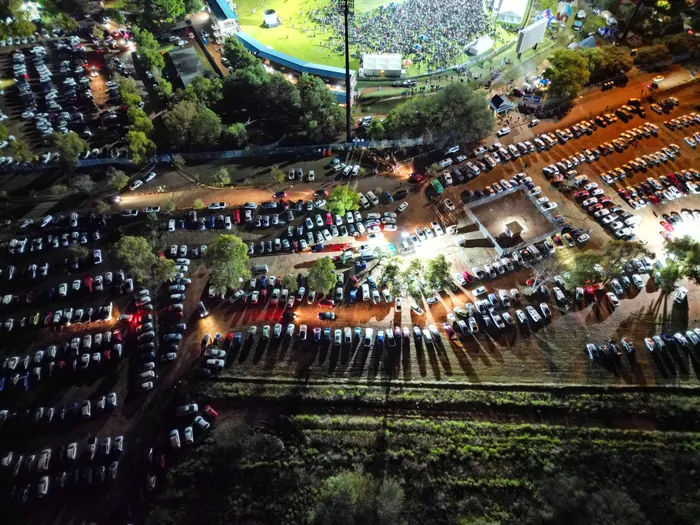Diamonds and Dorings a mixed bag in Kimberley

The thump of bass finally faded at 4 am. on Monday, ending a marathon Diamonds & Dorings Festival that for the first time unfolded inside the Kimberley Diamond Oval.
Image: Danie van der Lith
THE THUMP of bass finally faded at 4am on Monday, ending a marathon Diamonds & Dorings Festival that for the first time unfolded inside the Kimberley Diamond Oval cricket stadium.
Forced from its traditional Vaal‑side home at Langley Resort by flooding, the 26‑year‑old music showcase swapped river views for floodlights – and discovered the joys and jolts of life in a suburb.
A packed Oval, a quiet street
Organisers confirm that 8,000 tickets were scanned at the gates. “Attendance was substantially higher than last year’s post‑Covid comeback,” said Shantelle Engelbrecht, head of marketing for Exilite Holdings, the festival licence holder.
Security, she added, “was exceptionally tight with a visible SAPS presence, private guards, traffic officials and marshals”, resulting in an incident‑free event and no serious medical call‑outs.
A late‑night drive‑by by the Diamond Fields Advertiser shortly after 9pm found Cassandra’s streets eerily calm: no gridlock, no hooting taxi horns – just the distant rumble of synthesisers.
Engelbrecht credited a “comprehensive road‑traffic plan” that issued residents with driveway passes and earmarked clear lanes for emergency vehicles. “Traffic flow was consistent without the long queues usually associated with the event,” she said.

Parking around the Diamond Oval was well organised.
Image: Danie van der Lith
Music to some ears, migraine to others
For many inside the grounds, the vibe was worth the sleepless night. “The artists were good, the atmosphere was electric – no complaints,” grinned festivalgoer Jonathan Meintjies, still hoarse the next morning.
Four streets away, though, patience thinned. "Look, I have no problem with people enjoying themselves and letting off steam. But allowing this noise in a residential area is a bit unreasonable. I live four streets away, and I knew that I was going to have problems getting to sleep, and this concert went on till LATE!
"I can’t imagine how the people closer to the stadium must have felt. And if that’s not bad enough, they had rehearsals on Saturday night, and it ran till late. One night is bad. Two nights in a row, pretty intolerable!"
Another neighbour conceded she was “surprised” the disruption was mild – “The music only got really loud around 2am to 4am, but we managed.”
Engelbrecht insists organisers kept locals in the loop: flyers in postboxes, WhatsApp messages and a designated liaison. The finish time was formally extended from 2am to 4am by the multi‑agency Venue Operations Centre (VOC).
“All compliance was adhered to,” she said, adding that she “appreciates residents’ patience with this annual signature event.”
Rain, recycling, and rattling tills
A passing shower failed to scatter music revellers. On stage, a blend of local heroes and chart‑toppers pushed through to dawn, drawing cheers and kudos from Engelbrecht: “The crowd support was astounding.”
Behind the scenes, a waste‑management plan partnered with a recycling SMME, turning “a potential eyesore into revenue”. Vendors scored, too. Of over 200 applications, 71 small businesses were given free trading bays through the municipality.
Food queues snaked across the outfield; tills rang late.
No municipal funding was used, according to Engelbrecht – the festival was self‑financed – but the city still got something back. “This event is an economic driver,” Engelbrecht said. “It brings visitors, boosts tourism and creates temporary jobs.”
Residents noted one tangible fringe benefit: freshly filled potholes on approach roads, courtesy of pre‑event maintenance crews. But questions were asked. "Why must there be a big event in our area before the municipality fixes our roads?
Looking ahead
The municipality will now run an economic‑impact study before re‑advertising the 2026 hosting tender. Engelbrecht hopes to “scale the festival through additional sponsors” and says every edition teaches fresh lessons.
As for the venue? No promises. “There are no dates yet,” she said. “We evaluate annually in partnership with the city.”
Cassandra households, meanwhile, are bracing – or perhaps secretly hoping – for an encore. For now, though, quiet has settled over the suburb, leaving only the memory of basslines, neon lights and a debate as old as live music itself: when the beat is good, how loud is too loud?
Related Topics: